Anatomical Illustration
1627–1778
An important aspect of human anatomies published between 1627 and 1778 is the growing interest in function as well as structure. This period of anatomical illustration set in motion trends that continued through the modern period: 1) an emphasis on specific sections or divisions of the human body, 2) greater detail, and 3) a growing interest in the purpose as well as the structure of organs. The beginnings of physiology also fall into this period.
While Vesalian drawings such as those in Gibson's Anatomy of Humane Bodies Epitomized continue to be used, one finds new, highly detailed drawings such as those in Thomas Willis's Practice of Physick, seemingly a result of new thinking and new standards of art as well as the predominance of copper plate engraving over traditional wood cut reliefs.

Siboldus Hemsterhuis was a prominent doctor in Leeuwarden where he served as archiater for the court of Prince Willem Frederik of the House of Nassau-Dietz. Hemsterhuis's nephew was the well-known philologist Tiberius Hemsterhuis.
Messis Aurea, one of two books by Hemsterhuis, is really a compendium of texts on the lymphatic system by Jean Pecquet, Thomas Bartholin, and Olof Rudbeck, all written between 1651 and 1653. Based on earlier work by Gaspare Aselli, Pecquet established the lymphatic pathway within the abdominal-thoracic cavities. Between 1652 and 1653, Bartholin and Rudbeck each described the extensive lymphatic vessels throughout the body that drained not into the liver but into the blood via the thoracic duct. The claim to the primacy of this discovery led to a feud between the two that was set off by the 1654 publication of Messis Aurea.
The edition of Messis Aurea on display here was published five years after the first. It contained new illustrations by Rudbeck, including one of the lymphatic system in a dog. Ironically the title page of this edition reuses an engraving from Jean Riolan's Enchiridium Anatomicum (1649). Riolan was a Galenist and strong critic of William Harvey as well as of Bartholin.
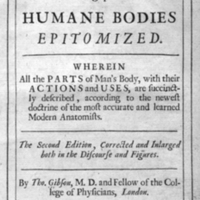
Thomas Gibson was born in England, but little is known of his early family life. He attended Leiden University where he received his medical degree in 1675. He was appointed physician-general to the British Army in 1719. His second wife, Anne, was the granddaughter of Oliver Cromwell.

The Anatomy of Humane Bodies Epitomized is of no great importance in its own right, as it does not contain much in the way of new anatomical findings. Gibson relied heavily on the works of other anatomists such as Alexander Read, Thomas Bartholin, Francis Glisson, William Harvey, and Marcello Malpighi, to name but a few. However, it is illustrative of the continued impact of Vesalius's anatomical drawings which were used throughout Gibson's book.
The Anatomy of Human Bodies Epitomized was published in eight editions, with each new edition being slightly improved and expanded. Gibson based his extensive text on Alexander Read's Manuall of Anatomy (1634). However, as the content was extensively revised and supplemented, Gibson claimed authorship. He did list his principal sources—27 anatomists were credited with text drawn from 33 titles—which was an uncommon practice at the time.
The plate on display shows the base of the human brain and the cranial nerves.
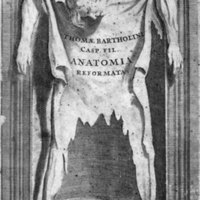
Thomas Bartholin was a member of an extensive family of physicians and anatomists and the son of famous anatomist Caspar Bartholin. The family was well respected as physicians and well-connected with the Danish ruling class. Thomas Bartholin was appointed professor of anatomy at the University of Copenhagen in 1648, an academic chair he held until 1661.
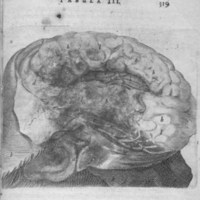
While studying in Leiden, Bartholin concerned himself chiefly with the study of the lymphatic vessels and William Harvey's theory of blood circulation. His most important contribution to anatomy and physiology was the discovery that the lymphatic system is an entirely separate system from the circulatory system; the lymphatics formed a never-before-described physiological system.
Bartholin wrote several anatomical treatises that were used by medical students as textbooks. In reality, however, these texts were largely revised and updated editions of his father's Institutiones Anatomicae (1611). Though the anatomical illustrations differed from edition to edition, few of them were original. Most were taken from works by Andreas Vesalius, Giulio Casseri, and others.
On display is Plate III, a hand-tinted engraving of a laterally dissected human brain.

This volume is another example of a revised and updated edition of Bartholin's Anatomia (here titled Anatome) published after the 1666 edition also seen in this exhibit. All editions of Anatomia, revised and expanded by Thomas Bartholin, were based upon the Institutiones Anatomicae (1611) of his father, Caspar Bartholin. While incorporating newer material and better illustrations in each successive edition of Anatomia, all editions followed the pattern set by Bartholin's first update, done in 1641, of his father's work.
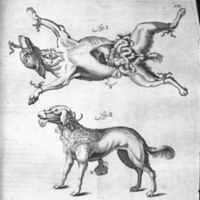
Of special note in this edition are the illustration and description of physiological experimentation. Plate XXI, displayed here, shows a dog which is part of an experimental procedure to collect pancreatic secretions from the pancreatic duct or common bile duct (the drawing is unclear). The first figure shows the surgical aspects of the experiment, and the second figure shows the recovered canine with the external and removable collection vial located under its abdomen.
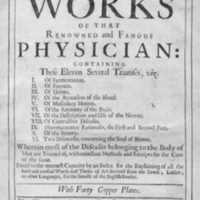
Thomas Willis was an English physician who made significant contributions to both iatrochemistry and anatomy. Especially renowned due to his advances in the areas of neurology and psychiatry, he tried to integrate both the mechanistic and the chemical theories of medicine to promote an understanding of bodily healing. Willis served as personal physician to King Charles I and was a founding member of the Royal Academy.
His most well-known published work was Cerebri Anatome (1664) which contains detailed drawings made with the help of the architect Christopher Wren. In Cerebri Anatome, Willis coined the term "neurology" and identified and described several important features of the human brain, such as the corpus callosum, the circle of Willis (a circle of arteries that supply blood to the brain), and the twelve cranial nerves.

Cerebri Anatome, included as Treatise VI in the edition of Dr. Willis's Practice of Physick on display here, presents an enormous contrast with the less
-detailed efforts of his predecessors. This plate consists of two figures of the base of the brain, with clearly illustrated cranial nerves. Figure I is an illustration of the human brain and cranial nerves. Figure II of the same plate shows the base of the brain and cranial nerves of a sheep.
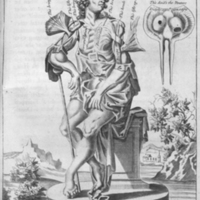
John Browne was a physician and anatomist who served Charles II and William III of England as Surgeon in Ordinary. He published original and innovative treatises on such subjects as tumors and treatment of wounds.
It is his most extensive work on anatomy, Myographia Nova, for which he is most remembered. Much of the text is plagiarized from William Molins's 1684 treatise, Myskotomia, Or the Anatomical Administration of All the Muscles of an Humane Body. Anatomical plates for Myographia Nova were taken without acknowledgement from other anatomical texts, many of them from Giulio Casseri's important treatise, Tabulae Anatomicae (1627). Although the plagiarism was exposed by another anatomist in 1685, the work was reprinted a number of times in both English and Latin.
Plate XIX depicts a dissected man carrying a walking stick and resting on a classical pedestal. The landscape background, though less detailed, is similar to ones found in the works of earlier master anatomists such as Andreas Vesalius and Adriaan van den Spiegel. The subject's upper arm and chest musculature is exposed, with individual muscles numbered for identification. The irony of depicting the anatomical models as courtiers is that only criminals, indigents, and strangers were allowed by law to be dissected for medical purposes.
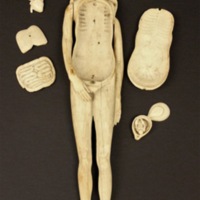
Ivory.
German [?].
ca. Eighteenth Century.
These rather simple anatomical models with removable organs were often used by physicians and midwives to instruct lay people on the anatomy of their bodies and especially on how human pregnancy takes place. Most of the extant examples are pregnant females—like the one on display here—giving special attention and care to the fetus growing in the gravid uterus. Note the uterus and the fetus are fashioned separately with a small thread representing the umbilical cord that connects the womb to the fetus. Organs other than those of reproduction are created with less care and detail.
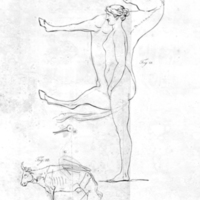
Peter Camper studied medicine at the University of Leiden, receiving his medical degree in 1746. He was a person of intense intellectual curiosity and wide interests, making contributions to the fields of anatomy, physiology, mathematics, anthropology, zoology, paleontology, art, and politics.
In On the Connexion between the Science of Anatomy and the Arts on display here, Camper combined his anatomical, anthropological, and artistic skills. The text of the book on the theory of drawing and comparing faces and forms is illustrated by 17 plates of extraordinary quality and originality. Quite significant is that Camper demonstrated one his most important anthropological theories called the "facial angle." He believed that more accurate drawings of human faces and heads could be made if one used the concept that different races and sub-groups have varying angles on the face.
Contrary to what one might assume, given the period's intense colonization, there are no overt claims of racial superiority in Camper's "facial angles." Figure 13 of Plate VII shows how a skilled artist can transform a drawing of a quadruped (horse) into a human female figure. In Figure 12 of the same plate, Camper demonstrates the transformation of quadrupeds into birds, or "how to change a cow into a crane."